BARCELONA — Dolby’s Atmos sound system shakes moviegoers with 51 speakers of ear-popping surround sound — and the company now claims to be recreating the Dolby Atmos effect in new phones and tablets. Can Dolby Atmos for mobile devices live up to its cinematic pedigree and meet Dolby’s claim that it will “really surprise people how much sound you can get out of a small device”? I tried it out here at Mobile World Congress 2015.
US sound company Dolby Laboratories, formed in the UK in 1965, specialises in helping your movies and music sound their best. Dolby makes tools to bring sound all the way from the mixing booth to your ears, whether you’re watching at home or in a theatre or listening on headphones or an expensive audio setup.


Now playing:
Watch this:
Dolby Atmos sound tech puts you in Smaug’s lair
2:48
Dolby Atmos is the firm’s cinematic flagship, a system that places 51 speakers around the theatre and pipes different sound out of each one to immerse you in the movie. Given the right film it can be an incredible experience — I experienced the meticulously-crafted sound design of “Gravity” in Dolby Atmos and I can’t overstate how much the sound played its part in drawing me into the bone-shaking drama of the story.
(On the other hand, I also saw “Noah” in Dolby Atmos, and that was just really loud.)
But there’s a world of difference between the immersive, multi-channel cinema experience and a pair of headphones plugged into a phone — so how do you go from 51 speakers to two and still create an immersive effect?
Dolby uses its knowledge of how sound reaches your ears to essentially simulate the effect of being surrounded by noise, with sounds from different sources taking an infinitesimally different amount of time to reach each lughole and even taking on a different tone as they travel. Your brain is trained to interpret those fractional differences and work out where the source is spatially.
Lenovo A7000 gives you a taste of Lollipop for $169 (pictures)






+5 more
More on Dolby
- Lenovo’s latest budget phone adds Dolby sound and a large screen
- Lenovo Tab 2 A10-70 Android tablet with Dolby audio chops
- ‘Transformers 4’ will be first Dolby Atmos Blu-ray
- Dolby Atmos at home: Ears on
I tried out Dolby Atmos on the Lenovo A8. Compared with standard stereo sound, it’s certainly a fuller sound. Dolby compares it to stepping into the rain instead of looking at the rain through a window, and — even though it’s not as directional as the cinema version, which allows you to pretty much point in the direction a specific sound is coming from, there is a strong sense of being amongst the things you’re seeing and hearing.
I should note that I tried out Dolby Atmos on a Lenovo tablet in the best possible conditions, watching bespoke videos and listening to a soundtrack designed to showcase Atmos, played through a pair of quality Sennheiser headphones. Dolby reckons the effect will work on lower-quality earbuds too — like the ones that come with the Lenovo devices, but it’s clear that a pair of earbuds blocking out the noise of the 8:15 to Fenchurch Street aren’t going to offer the same ear-popping experience as a proper cinematic sound setup.
Now here’s the giant catch: like 4K, virtual reality and other new technology, the content hasn’t caught up with the tech. As of right now, 230 movies have been mixed in Dolby Atmos; around 18 have made it to Blu-ray; none are available to download to your mobile phone. Dolby Atmos for mobiles will upscale the audio quality of existing non-Atmos sources, but for the moment your ears will have to put up with the sound you’re used to.


Now playing:
Watch this:
Lenovo’s latest budget phone adds Dolby sound and a large…
0:52




